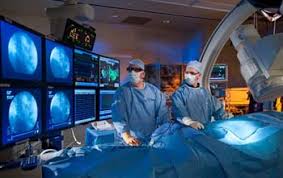What Is Atrial Fibrillation (AFib) Ablation?
Atrial fibrillation ablation is a percutaneous procedure (not open heart surgery) that is performed to try to correct the heart rhythm – or stop AFib.
AFib causes the upper chamber of your heart to quiver fast. This is caused by abnormal electrical activity in the atria. AFib is commonly triggered by fast electrical discharges coming from the pulmonary veins. The procedure targets the areas with abnormal activity and the main focus is to isolate the pulmonary veins.
By creating scar tissue, AFib ablation blocks the erratic signals, helping restore a normal heart rhythm and significantly improving quality of life. This procedure is performed by expert electrophysiologists, including Dr. Jose Osorio, who has performed over 8,000 AFib ablations and at least 5000 without the use of fluoroscopy, reducing or eliminating the radiation exposure for patients.
Benefits of AFib Ablation
Studies show that AFib ablation can:
- Improve quality of life
- Decrease ER and hospital visits
- Reduce the risk of persistent AFib
- Improve heart function, especially in patients with congestive heart failure
- Lower the risk of developing dementia
How Is AFib Ablation Performed?
During AFib ablation, doctors use catheters to perform the ablation and different tools to guide the ablation:
- Fluoroscopy or X-ray
- Intracardiac Echo which is the use of a small ultrasound probe inside your heart for better visualization
- 3D mapping system which is a technology that allows us to know where the catheter is inside the patient’s body, create a 3D reconstruction of the heart, and map the arrhythmias (finding where they come from)
Technology for AFib Ablation
AFib ablation can be performed using different energy technologies:
- Pulsed Field Ablation which is a new technology, not yet approved in the US. Several clinical trials have been completed in the US, highlighting the safety of this technology which is already approved in Europe
- Radiofrequency
- Cryoablation
Pulsed Field Ablation
Radiofrequency Ablation of the Pulmonary Veins
An ablation catheter is positioned at the pulmonary vein and ablation is performed by heating the tissue. Ablation is guided by a circular catheter called Lasso. There are many catheters approved for AFib ablation and different mapping systems can be used to guide the procedure.
Cryoballoon Ablation of the Pulmonary Vein
Cryoballoon is used to deliver very cold temperatures to the mouth of the pulmonary veins.
AFib Ablation and X-ray Exposure
 AFib ablation is typically performed using fluoroscopy (X-ray image) and a 3D mapping system. High exposure to X-rays can be detrimental, and it may even cause cancer or blood disorders. We perform AFib ablations using minimal or even no fluoroscopy at all.
AFib ablation is typically performed using fluoroscopy (X-ray image) and a 3D mapping system. High exposure to X-rays can be detrimental, and it may even cause cancer or blood disorders. We perform AFib ablations using minimal or even no fluoroscopy at all.
We have extensive experience in performing procedures using minimal or no fluoroscopy, and over 6000 procedures have been performed using this novel technique by Dr Jose Osorio. Hundreds of doctors from the US and other countries have learned this technique from Dr Osorio.
Dr Jose Osorio
Miami, FL
Read More About AFib:




